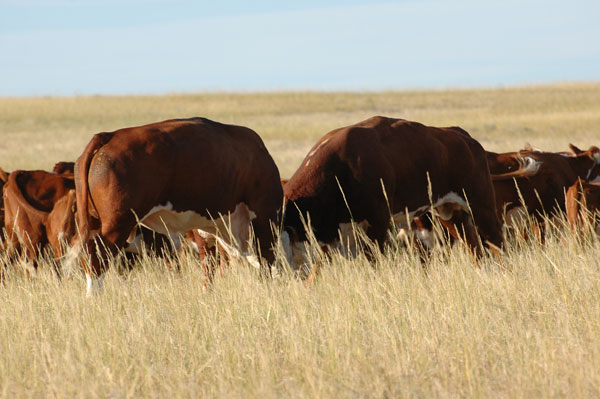The Measure Of A Bull’s Worth – Part One
Highly prolific bulls make you money. Sluggards cost you money. Problem is, how do you know which is which?

Here’s a different way to look at your bull battery: Think of them as employees. Just as with any group of employees, you’re going to have some with an exceptional work ethic – they get there early, stay late and are always looking for something else to do. Then you have some who show up on time, do what needs to be done and go home. They pull their weight and do what’s expected of them, but no more.
Then you have some who don’t do much more than sit in the shade and hope everyone else covers for them.
Your bull battery is just like that, says Dan Drake, University of California Extension livestock and natural resources farm advisor in Siskiyou County, which is in the far northern reaches of the state. The problem is that ranchers have never been able to tell which bulls make them money and which are on welfare. Just because they pass a breeding soundness exam doesn’t tell you whether they have the work ethic to get cows bred and, more importantly, settle cows early in the breeding season.
Speaking at a meeting of the National Beef Cattle Evaluation Consortium (NBCEC) this week in Kansas City, Drake detailed the results of a three-year study involving around 2,100 commercial cows run with a 25:1 cows-to-bull ratio on three Northern California ranches. What the study found may surprise you.
Using DNA marker technology, Drake says combining three ranches across 15 calf crops (two ranches had both spring and fall calving herds) the average was 19.2 calves/bull. “I’ve always contended that 20 calves is what an average bull will produce and this supports that pretty well,” he says.
A Closer Look: Commercial Cattleman Builds Back His Herd Using DNA Marker Technology
But averages can be very misleading. Thanks to DNA parenting technology, Drake says the range of calves sired by each bull ran from zero to 64 in one case. Excluding the rock stars, Drake says every calf crop showed some bulls were siring 40 or more calves compared with others that were siring very few.
And that’s important to know from both a profitability perspective and reaching your long-term genetic goals. That’s because the data show that not only did some bulls sire most of the calves in the calf crop, but they did so earlier in the breeding season.
That’s important for two reasons, Drake says. The first is profitability. The most prolific bulls weren’t necessarily the ones that sired the heaviest calves based on individual weaning weights. But because they sired more calves, and the calves were typically born earlier in the calving season, they produced more total pounds and returned more total dollars to the ranch than bulls that sired heavier calves but fewer of them.
From a genetics standpoint, those bulls also sired most of the heifers that went back in the herd. “Whether we like it or not, the genetics we get in our replacement heifers are the genetics of the prolific bulls,” Drake says.
DNA parenting technology is very helpful in identifying which sires are making you money, and which aren’t even paying the feed bill. And it may not be necessary to sample the entire calf crop, he says. Since the data show that the highly prolific bulls tend to sire more of their calves early in the breeding season, he says you can more efficiently spend the money and sample only the calves born in the first five weeks of the calving season.
Like what you are reading? Subscribe to BEEF Daily for industry news in your inbox every Monday-Thursday.
Beyond that, they looked at each bull’s EPDs and heated up a few computers crunching the numbers every way they could think of. “We did find that the scrotal circumference EPD was related to prolificacy,” Drake says. However, it only explained about 5% of the variation, so it didn’t tell the whole story.
Nonetheless, he says scrotal-circumference EPDs seem to indicate a bull with more capacity to breed cows and may be something to consider when making bull-buying decisions.
Next week, we’ll dig a little deeper into the economics of high-performing bulls. Can you determine which bulls sire calves that you can retain through the feedyard and make money on a packer grid? Or are your bulls siring calves better sold as feeders on the cash market? Or can you sort your calves based on sire, and do both?
You might also like:
Ag Lending Tips For Cattle Producers
Video: Animal Welfare: Why It Is Always Important To You
Commercial Cattleman Builds Back His Herd Using DNA Marker Technology
About the Author(s)
You May Also Like


.png?width=300&auto=webp&quality=80&disable=upscale)
